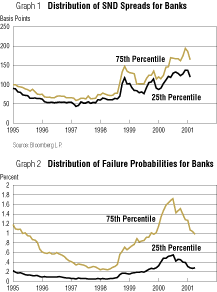A lack of supervisory familiarity with market data signals currently hinders the incorporation of market data into summary assessments of bank condition. In short, supervisors are unsure what constitutes a significant level, change or trend in a market data signal like an SND spread or a failure probability derived from an equity-based model. Information on the distribution of past values of such market data signals can help address this supervisory concern. Such analyses are useful not because of their predictive ability but because they can provide "benchmarks" to place the market data signals supervisors observe into a recent historical context.
An analysis of the past levels of SND spreads for large banking organizations can provide useful information about what constitutes an "atypical" SND spread in the current period. Graph 1 shows this market data signal at the 75th percentile (the SND spread that is greater than 75 percent of all observations) and the 25th percentile (the SND spread that is greater than only 25 percent of all observations) based on data from 145 SND issues from approximately 50 banking organizations that had outstanding SND during the last six years. Supervisors can use such information to determine if SND spreads at institutions they supervise fall between levels they consider "normal" based on recent history. For example, if supervisors observed an SND spread at a bank of 250 basis points (a basis point is 1/100 of a percentage point), they could reasonably conclude that the market's perception of risk at the bank was abnormally high, given that SND spreads over the past two years have ranged between 80 and 200 basis points for most banks issuing traded SND.
Graph 2 displays the results of a similar analysis performed on the failure probabilities for roughly 600 commercial banks that were generated by one firm's equity-based model.* As with SND spreads, supervisors could use this information to determine if the observed failure probability were "atypical" based on recent historical values. If the bank in the previous example had a failure probability of 2.5 percent, supervisors again could reasonably conclude that the market considered its level of risk atypically high relative to the performance of the banking industry during the last two years.

In addition to knowing if the levels of a market data signal are "normal," supervisors also are concerned about whether changes or movements in the signal are abnormally large. The datasets used in the above analyses were re-examined to determine what constituted a typical change in the signal. For example, only 15 percent of the monthly changes in SND spreads for commercial banks were greater than plus/minus 20 basis points. Likewise, only 15 percent of the monthly changes in the failure probabilities were greater than plus/minus 30 percent.
As noted earlier, these analyses provide context for the market data signals that supervisors observe. The period for which we reviewed data was a particularly prosperous time for banks. Comparisons between future values and these "benchmarks" hold only to the degree current and future periods are similar.
*The model used for this analysis is KMV LLC's Credit Monitor(r) and the failure probabilities that it calculates are termed "expected default frequencies," or EDFs(tm).
Return to: Market Data and Bank Supervision: The Transition to Practical Use





